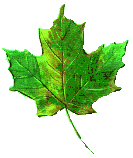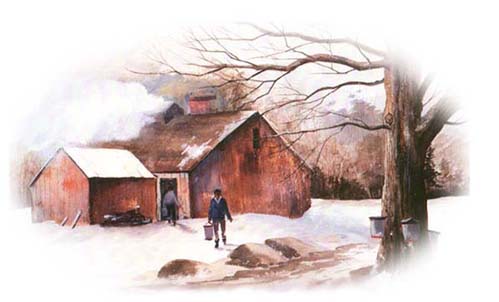SUGARIN'
 by bartermn
by bartermn
3/17/97
Spring has sprung and I see smoke coming from the local
sugar shacks. I've collected almost enough sap to make it worth my
time to join them.
We don't have any sugar maples (Acer saccharum) on our two
acres so I tap the only ones we do have, silver or soft maple
(Acer saccharinum). The sugar content of the sap isn't as high, it
takes more sap to make the same amount of syrup. Our trees go to
bud sooner than the sugars so I keep an eye on the tips of the branches,
watching for them to turn red. As the trees begin to bud, chemical
changes in the sap give the syrup an unpleasant flavor.
Most maples can be tapped to provide sap for syrup, but did
you know that birches, butternuts, alders, hickories, and even
black walnuts have been used for making natural sweeteners?
Many of the syrup camps collect their sap through plastic
tubing that leads to large bulk tanks. We simply attach milk
jugs to the spiles with a piece of baling twine or cut a slit in
the side of the jug for an S hook if the spile is store bought
and drilled for it. I do own a couple of 'real' ones but most
of my spiles are made form bamboo, sumac, willow, or short sections
of curtain rod.
Once a jug is full, it is emptied into a five gallon bucket
and set in a cool spot near the woodshed until I get twenty gallons
or the weather turns too warm. A day or two of fifty degree weather
will sour the sap, and though I have used some sour sap for my syrup
and couldn't taste the difference, Gin could and wouldn't put it
on her pancakes but would use it for cookies, icings, and other
baked goods.
Twenty gallons of sap will boil down to about a half gallon of
syrup. I used our roasting pan for years and spent more time cleaning
it than it took to make the syrup. While searching for some lumber
in a neighbor's shed to rebuild his porch with, I discovered
a real batch pan he had used in his syrup business years before.
I traded him an hour's labor for it. I will still need to scrub
the soot from it afterwards but at least I won't have to listen
to Gin scold me while I do it.
I build a fire in the bar-b-q pit early on the morning I plan
to make syrup. After chores I spend the rest of the day stoking
the fire and adding sap to the shallow pan until the syrup starts
to thicken. I made a skimmer from a piece of screen and a coat
hanger to remove the foam and occasional ashes that float into
the sap. When the liquid runs off the skimmer in thin sheets I
pour the remaining syrup into a sauce pan for pasteurizing in the
kitchen. Using a candy thermometer, it is heated to
160 degrees then poured into canning jars, usually half-pint
jelly jars. It keeps fine in our pantry for a year or more. Without
the pasteurizing, the syrup might tend to crystallize or mold.
The syrup could also be kept in a freezer, it won't freeze and
will retain it's color and flavor.
Even though I loose a day's wage, making my own syrup rewards
me in other ways. The first camp fire of the year reminds me
of camping trips to the school tree farm as a boy scout. A sip
of the sap before it's cooked brings back even earlier memories,
of living in the Adirondack mountains and walking to Mrs. Carter's
one room school house. My brothers and I would take a pail off
one of the tapped maples along the route and let the sap drip onto
our tongues, making us true 'sap suckers.' Sitting at the fire
pit, watching the sap boil puts my mind at ease, arranges my
priorities for the coming year, and lets my mind wander wherever
it wants. It brings me peace.
